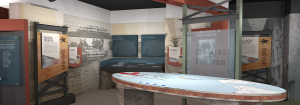Militia Era Gallery

The National Guard traces its heritage back nearly four centuries to December 1636, when the Massachusetts Bay Colony ordered local militia companies to muster the following spring. Militia units served during the American Revolution and in all major conflicts during the 19th century. The term National Guard first came into widespread use in the 1870s; that same decade the National Guard Association of the United States was founded.
Don’t miss:
A Brown Bess musket, a standard British firearm used during the Revolution, belonged to a soldier in the regiment that fought against the minutemen at Concord Bridge in April 1775
A militia order dated April 20, 1775, ordering troops to assemble North of Boston the day after the Battle of Lexington and Concord began the Revolutionary War
Coming of Age Gallery

A series of legislative acts modernized the National Guard in the early 20th century, standardizing training and drill pay. When America went to war in 1917, men from all 17 Guard divisions were sent overseas to fight as part of the first complete mobilization of the National Guard. Notable units and divisions include the 42nd Rainbow Division made up of Guard units from across the country, as well as the 369th Infantry Regiment, the first African American and Puerto Rican infantry regiment to serve overseas during World War I.
Don’t miss:
Military equipment and personal items belonging to Private Thomas Dale Reno, a Pennsylvania Guardsman who served in World War I when he was 19 years old
World War II Era Gallery
 The Citizen-Soldier in WWII Gallery opened on November 15th, 2015 to great acclaim. Loaded with new artifacts and an interactive map-table telling the chronology of National Guard Division participation, the new Gallery tells a comprehensive story beginning with Mobilization in September of 1940 and the Louisiana Great Maneuvers.
The Citizen-Soldier in WWII Gallery opened on November 15th, 2015 to great acclaim. Loaded with new artifacts and an interactive map-table telling the chronology of National Guard Division participation, the new Gallery tells a comprehensive story beginning with Mobilization in September of 1940 and the Louisiana Great Maneuvers.
Following the Pearl Harbor attack in 1941, the United States entered World War II, deploying all 18 Guard divisions overseas. Notably, Guardsmen participated in the D-Day invasion and the liberation of Nazi concentration camps. They suffered through and survived the Bataan Death March. The 34th “Red Bull” Division set a record for most consecutive days in combat while serving in the European Theater, and the 29th Infantry Division participated in the D-Day invasion of Normandy in June 1944.
Don’t miss:
The jacket belonging to Gen. George C. Marshall, who served as the chief instructor for the Illinois Guard’s 33rd Division before becoming chief of staff to the Army in 1940.
The pistol fired by LtCol Felix Sparks when the gates opened for the first time liberating the prisoners of Dachau Concentration camp north of Munich, GE, April of 1945.
Cold War Era Gallery

The Cold War was a time of uncertainty for the Guard. While troops served in both the Korea and Vietnam wars, their numbers were much fewer than in previous conflicts as national leaders hesitated to send the Guard to war. The social turmoil at home placed a heavy burden on Guardsmen who were called up to respond to protests and riots throughout the nation. As the Vietnam War came to a close, national defense policies shifted to allow the Guard a more central role in future conflicts. Throughout the 1980s and 1990s, Guardsmen served in peacekeeping roles all over the world in addition to providing domestic relief when called upon.
Don’t miss:
The uniform belonging to Capt. Norma Parsons Erb, the first female officer in the Air National Guard
The bayonet that belonged to Medal of Honor recipient Capt. Lewis Millett
9/11 Era Gallery

The Guard’s response to the September 11 terrorist attacks and its subsequent contributions to the War on Terrorism highlight the Guard’s expanding role in major combat operations. Guardsmen served in Operation Iraqi Freedom and are still stationed in Afghanistan providing security and training as part of Operation Enduring Freedom. The past decade also saw the growth of the State Partnership Program as well as the addition of the chief of the National Guard Bureau to the Joint Chiefs of Staff. The Guard’s response to Hurricane Katrina in 2005 was the largest deployment ever for a natural disaster.
Don’t miss:
Steel beams from the World Trade Center
The uniform worn by Sgt. Howard Wulforst, a Guardsman who participated in recovery and security missions at Ground Zero after September 11
The Memorial Wall dedicated to Guardsmen who lost their lives in support of the War on Terrorism

